Bal Harbour Shops’ Movable Feast
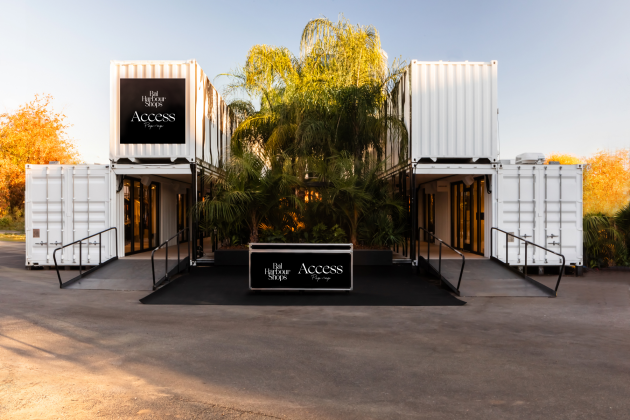
A portable mini mall?
In effect that’s what Bal Harbour Shops has created in a bid to tap markets well beyond its presence at 9700 Collins Avenue in Bal Harbour, Fla., and build shopper loyalty. It’s called the Bal Harbour Shops Access Pop-Up and it’s designed with 30 shipping containers so it can be moved around the country.
More from WWD
“The real objective is grow the ranks of those in our Access loyalty program and bring the Bal Harbour Shops experience outside of Bal Harbour,” explained Matthew Whitman Lazenby, president and chief executive officer of Whitman Family Development, a family business that owns the 450,000-square-foot Bal Harbour Shops open-air luxury shopping center and is the co-developer of the retail components of Miami’s Brickell City Centre.
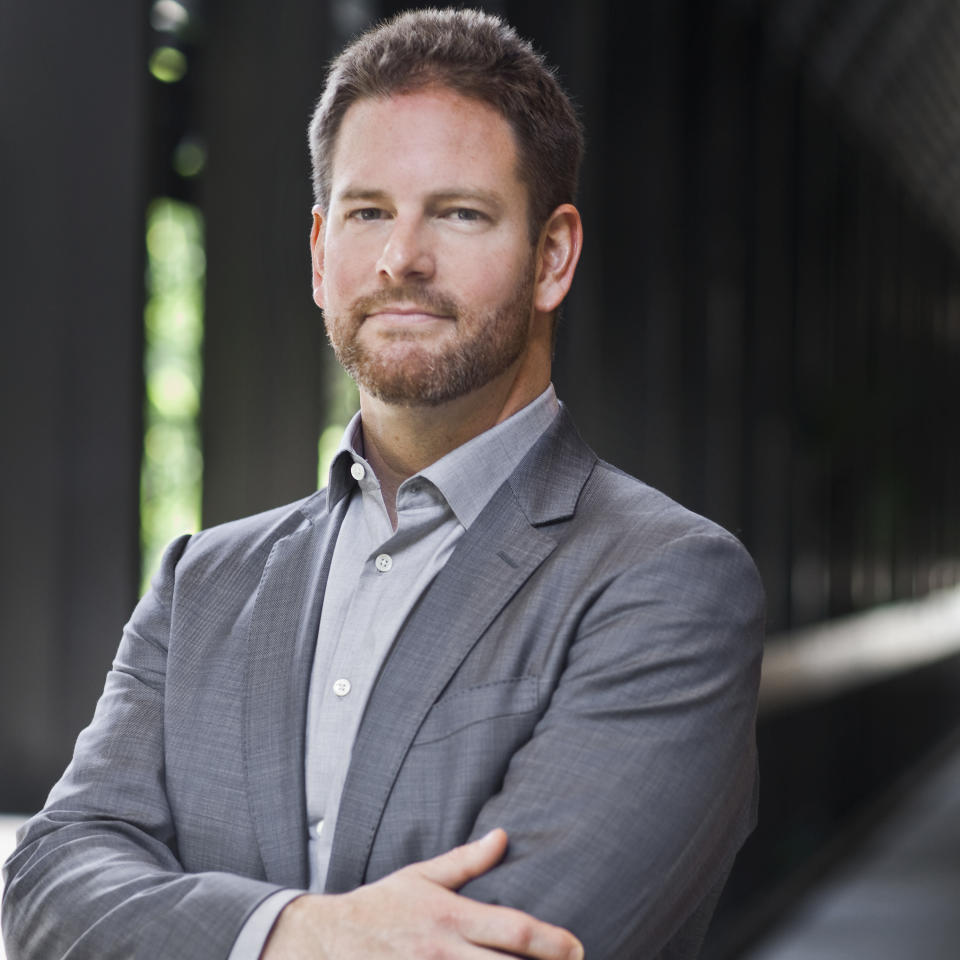
The Bal Harbour Shops Access Pop-Up has been operating in Raleigh, N.C., since Nov. 21 with a roster of luxury shops including Tiffany & Co., Balmain, Frette, James Perse, Scanlan Theodore, Santa Maria Novella, Bonpoint, Assouline and Addict. While visiting the pop-up, joining the Access loyalty program is encouraged.
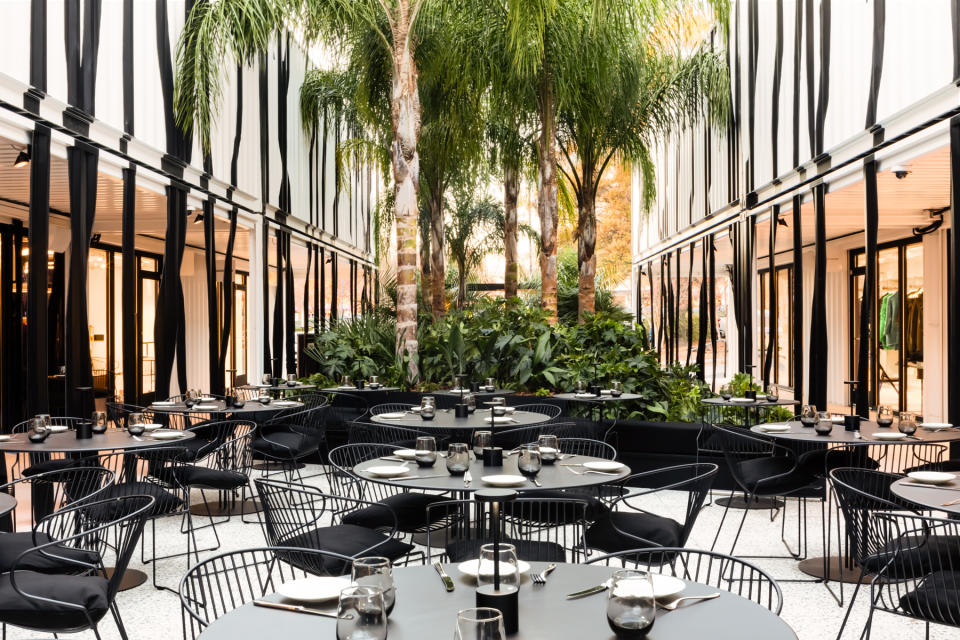
Designed and custom-built by LOT-EK, an architecture and design firm based in New York and Milan, the site replicates the zen-like atmosphere of Bal Harbour Shops. Landscape architect Raymond Jungles has filled the pop-up with palm trees, koi ponds, fountains, and lush greenery. He’s been doing all the landscape projects for Bal Harbour Shops.
The setting has covered walkways with overhead fans, a retractable canopy, and a restaurant called “The Whitman” operated by Constellation, a national catering company. The restaurant has a bar, a lounge and indoor and outdoor seating.
In the middle of it all are the retail stores, occupying a total of 17,000 square feet and sitting on a pad that’s roughly three or four times that size considering the back-of-house operations.
“There is nothing new about retail pop-ups,” Lazenby said. “Luxury brands have done pop-ups, but this is the first time it’s on a scale of a shopping center,” albeit a smaller scale.
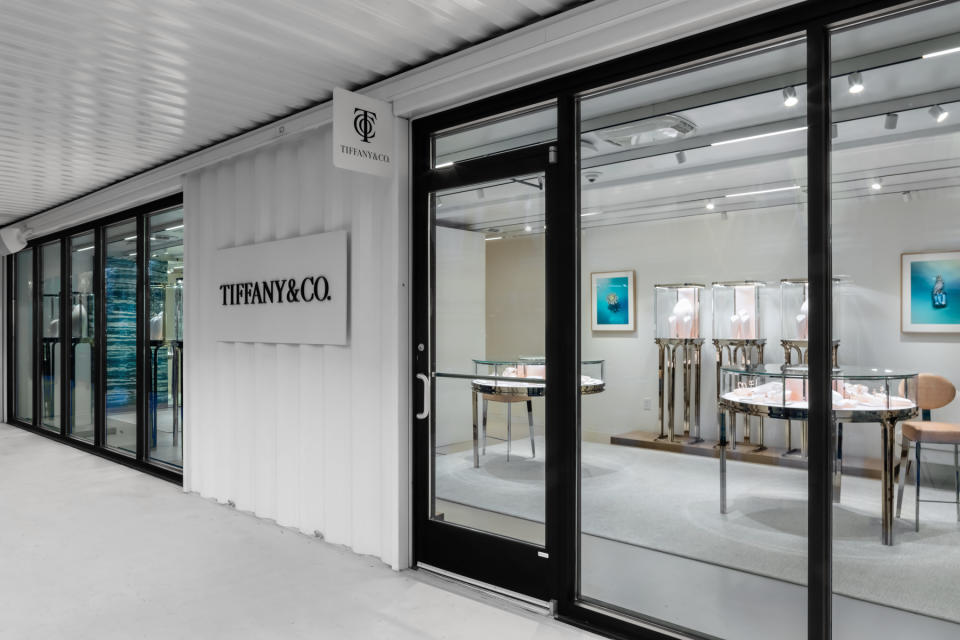
Tiffany at the Bal Harbour Shops Access Pop-Up.
Brands have custom-built, air-conditioned boutiques with crisp white glass front spaces. They’re fitted out with furniture, panels, shelving and vitrines to highlight merchandise. Boutiques range from 250 square feet to nearly 700 square feet or more in size, Tiffany’s being the largest.
The Access Pop-Up in Raleigh will operate for eight weeks before being dismantled, transported and reassembled in Tequesta, Fla., which is next to the city of Jupiter. Eight weeks later, it will relocate again to Fort Walton on the Florida Gulf Coast, followed by Greenville, S.C.
According to Lazenby, the concept stems from the success Bal Harbour Shops has had with targeted events, which typically partner with a luxury tenant taking product off-site to a hotel, a condominium, or a country club, or for an event, such as the Formula One in Miami.
The movable format can be assembled in as little as a week, Lazenby said, adding, “It’s a faithful recreation of Bal Harbour Shops. We have been seeking out areas of ultra high net worth, where there is no meaningful amount of luxury.”
The Access Pop-Up locations selected so far are within relative easy traveling distance from Bal Harbour, which is located in north Miami Beach. But the execution isn’t so easy. “After we convince our landlord partners, we have to sit down in front of cities and counties and get these things approved. They look at us like we’ve got five heads,” Lazenby said.
Talking demographics and psychographics, Lazenby said, “You can argue that some of these markets are built on old-fashioned, conservative dollars,” where luxury is not particularly high on shopping lists. “But one of the other things we found is that for our tenants, these markets, where they might not have a brick-and-mortar location, tended to score high on their own e-commerce platforms.” He also said that Bal Harbour Shops’ luxury tenants selling inside a multilabel retailer in one of these markets generate healthy sales there.
Lazenby said the response to Bal Harbour Shops Access Pop-Up in Raleigh has been “fabulous” and that the business has been supported by “heavy eventing in the market.”
The format, he said, is “fun. It’s different,” and it’s hoped it leads to personal shoppers building relationships with local consumers, after the pop-up moves away.
“Because this is new territory, the traditional financial arrangement between landlord and tenant is not how this is really structured,” Lazenby said. “Tenants pay a sponsorship fee to participate.”
That fee is determined by the level of services and work provided by Bal Harbour Shops, such as providing staff to man the store, or taking care of the inventory.
“We offer a suite of services. Brands supply the product, we can do everything else. The size of the fee is based on how much work we are doing. If the tenant staffs the store and takes care of inventory, they would be charged a smaller fee. For individual brands trying out these markets, number one, they are going to have to spend some amount building out the pop-up and they will spend a fortune to make it their own.
“At Bal Harbour Shops, we have more than 100 stores. At Bal Harbour Shops Access Pop-Up, we can only fit 10,” Lazenby said. “But we think there is a clear tie-in back to Bal Harbour Shops.”
The containers, fabricated by the Atlanta-based BMarko Structures, are stacked two high, to create the illusion of two levels though everything is occurring on the ground floor. Some of the luxury boutiques are two or three containers deep, or a boutique might be composed of two containers, side-by-side. A larger store, such as Tiffany, will be composed of three or four containers.
“Shipping containers are extremely versatile, but for this set-up you have to find an almost perfectly flat site. It’s a topographical restraint,” said Lazenby.
“If we are successful in this, we hope to leave behind a personal shopping program,” said Lazenby. “If the demand for luxury is so great, we would consider developing a concept that is year-round.”
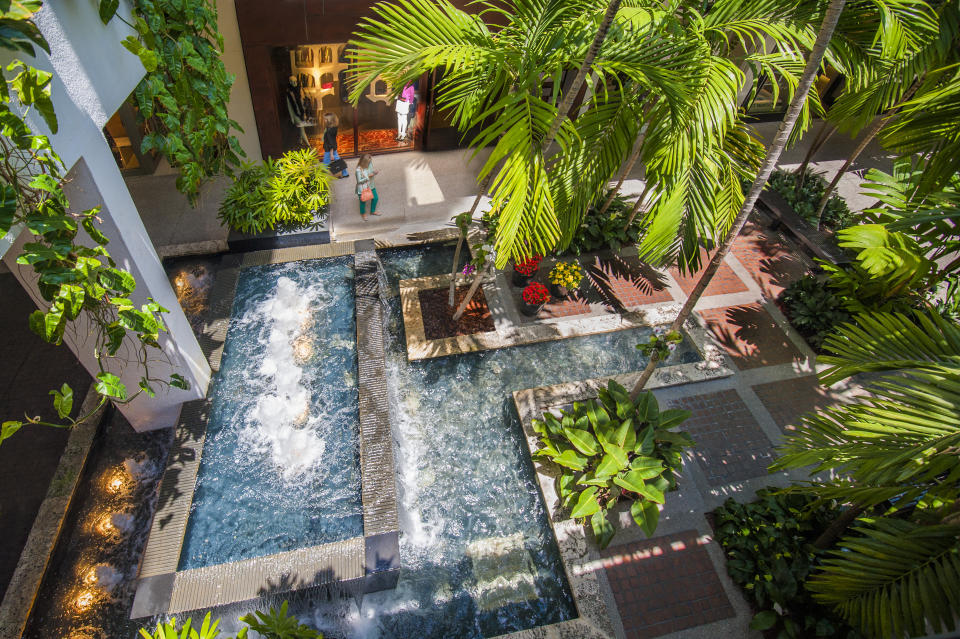
The courtyard at Bal Harbour Shops.
This year, the Bal Harbour Shops magazine celebrates its 20th birthday. According to Lazenby, the magazine evolved from a catalogue with page after page of ads, to a true magazine rich with editorial, and with plenty of ads as well.
“The magazine and its success has led to us exploring how the Bal Harbour Shops brand can be more prominent,” Lazenby said.
Among the steps to raise the destination’s profile and increase its business, a media division was formed, with the magazine a component of it.
In addition, Bal Harbour Shops branded merchandise was recently launched, including T-shirts and sweatshirts. The program is expected to grow with additional items.
Also, an Access lounge for private dining, personal shopping and refreshments will be opening in the center prior to holiday 2024.
The Bal Harbour Shops 200,000-square-foot expansion is slowly progressing. A new parking garage was completed last April. It connects to the common areas, and along its white walls, there’s a 100-foot long gallery displaying Bal Harbour magazine covers and advertisements from the past as far back as the ’60s and ’70s. The old parking garage, where the new retail footprint will be, was demolished earlier this year.
At times the expansion has been stalled for a combination of reasons, like local concerns that had to be resolved for approvals. Then there were COVID-19, supply chain bottlenecks, labor issues, and ever-increasing material costs.
Barneys New York had agreed to move in with a 50,000-square-foot store, but Barneys went bankrupt, nixing the plan. As an alternative, “We decided to amp up the amount of restaurant offerings,” Lazenby said, thereby doubling the restaurant count from the current six to eventually at least a dozen.
Other space in the expansion will be occupied by a combination of certain luxury brands entering Bal Harbour Shops, such as Dior, Cartier, Gabriela Hearst and Eden Gallery Art, and others such as Graff, Saint Laurent, Alexander McQueen, Bottega Veneta and Burberry relocating existing stores to the expansion, typically with larger spaces. “We are pushing hard to make a 2025 opening, but certainly it will happen by 2026. Even though construction in Florida was deemed essential, the work was hit hard by COVID,” said Lazenby, who acknowledged frustration with delays and costs involved.
Receiving building materials can be slow. “Now it can take over a year to get electrical switch gear. You can’t operate in the dark,” Lazenby said.
There was also some distraction caused by a dispute with Saks Fifth Avenue, an anchor tenant. In 2020, Bal Harbour Shops sought to evict Saks claiming “extensive arrearages,” including overdue rent. A lawsuit against Saks was filed, seeking to terminate the lease and evict the store. Saks countersued, claiming Lazenby breached the parties’ contract and Bal Harbour’s fiduciary duty and that in an effort to increase pressure on the retailer to resolve the dispute related to lease payments during the COVID-19 pandemic, Lazenby disclosed confidential information to the media.
Lazenby declined to comment on the case, which is still pending.
The good news is that the expansion is fully leased, there have been some recent openings in the center, and additional openings are seen happening through the center in mid-to-late 2024.
“Miami is having a moment and it’s lasting,” Lazenby said. “People are flocking to south Florida. Florida has always been a great place to live and work. It’s a great retirement destination. There’s no state income tax and Florida is a business-friendly state. Miami in particular is just exploding, but affordable housing is a critical issue. People are being priced out left and right. It’s a problem that must be solved. It’s not our customer but Bal Harbour Shops won’t have much of a customer if construction workers and those providing critical services can’t afford to live here.”
Asked how traffic has been lately, Lazenby said 2022 was “up significantly, double digits over 2021. The trend continued into 2023. By midiyear it started to plateau. It’s been wobbly since. We tend to hear it’s the same in markets like Bal Harbour. There is still a very resilient luxury customer continuing to spend at the highest price points.” However, business with the “aspirational customer” has been waning, though the luxury stores at Bal Harbour Shops rely less heavily on that segment, Lazenby said. “When we ask our stores about business, they say high-end product keeps moving.”
Opened in 1965 by the late Stanley Whitman, a retail visionary, the family-owned Bal Harbour Shops has long been among the most productive centers in the country, based on sales per square foot, which in peak years ranged from $2,000 to $3,000.
Whitman, whose house was on the site of Bal Harbour Shops, saw the potential in luxury long before the rest of the shopping-center industry. He came up with the concept of bringing the luxury retailers of Fifth Avenue to Miami Beach and foresaw that Miami as a tourist mecca would only grow, and that tourism and luxury would be a potent combination. Bal Harbour Shops was the first all-luxury fashion center in America featuring high-end retailers in a tropical, open-air setting, and the first to make lush landscaping integral to the design and the experience, providing a unique setting decades before the term “experiential” became an industry catch-word and being experiential became paramount for survival.
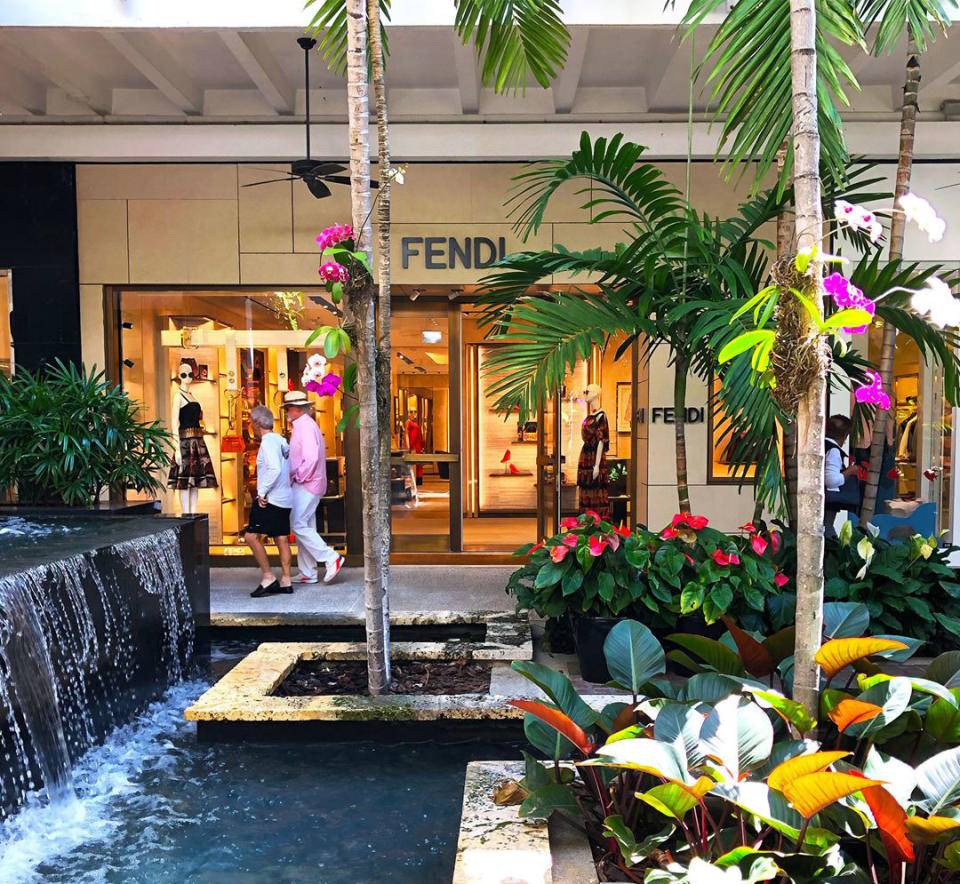
Best of WWD